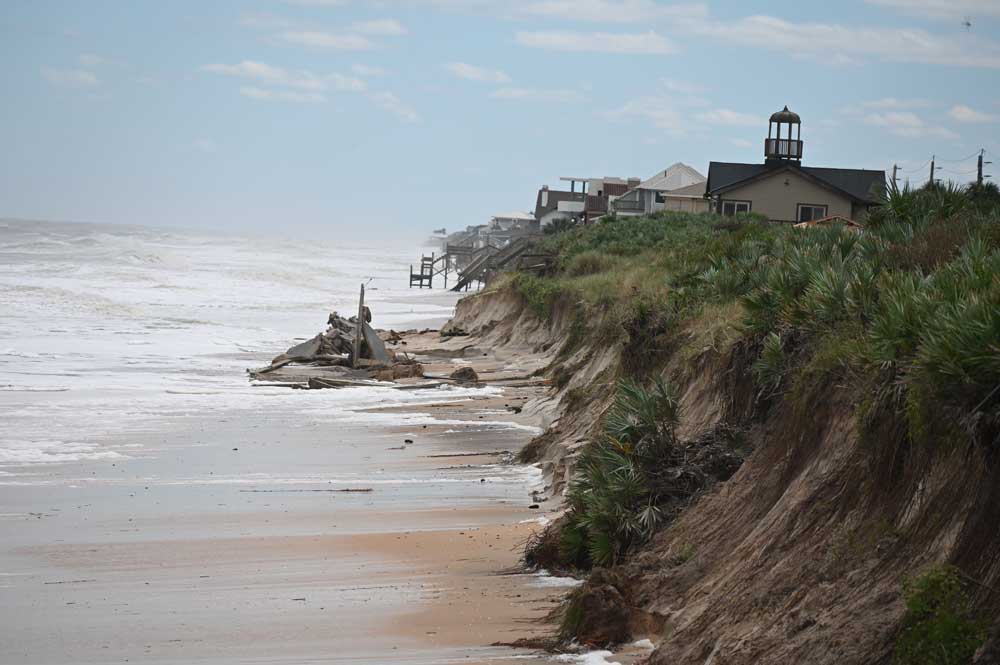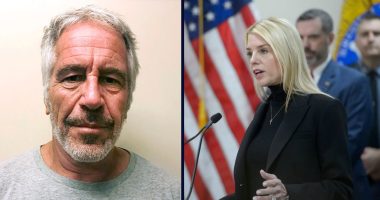
Note: This is the second of two articles on Monday’s decision by the County Commission to seek a permanent new levy for beach protection. See: “Flagler Seeks New Countywide Tax of Homes and Businesses for Beach Protection, But Cities’ Support Is Key.”
Monday’s milestone by the Flagler County Commission–seeking a new funding mechanism to rebuild and maintain the county’s 18 miles of beaches–was the culmination of a four-year process. It would put in place a method to pay for expected beach maintenance for decades as the county faces a new reality of rising seas and relentless erosion.
The board in 2019 agreed to develop what every other coastal county in the state already had: a beach management plan for the county. The beach-management study was commissioned in 2021.
The county’s shore will see the U.S. Army Corps of Engineers’ beach-renourishment, or rebuilding, project begins in a matter of days in Flagler Beach, eventually covering the area between the north edge of Gamble Rogers State Recreation Area and North 7th Street. That project has been over 20 years in the making.
It’s got a 50-year timeline, with four subsequent renourishments scheduled over that span. Only the initial beach-rebuilding is paid for. While the federal government will pay half the cost of future renourishments, it will inly do so if Flagler County assumes the cost of he other half. Otherwise, the federal government will abandon the project–and the beach. The mechanism the county is putting in place would help pay for those subsequent renourishments, and likely draw down state dollars as well.
Just as significantly, it would also extend that plan to the rest of the county’s beaches, which do not benefit from federalized help.
In 2025, the county intends to apply the same approach to the area from North 7th to Varn Park, what it calls Phase 2. It has no money for that. The new tax would provide it.
Phase 3 will extend the renourishment to the north end of the county’s shore, at Washington Oaks State Park, and where the sanding will have to take a more measured approach to account for the coquina rocks, which can’t just be buried. A further phase with trucked in sand would account for the area from the state park to Marineland. The non-Army Corps phases are controlled by the county’s ability to secure permits.
“So we hope to have over nine miles or half of Flagler County’s coastline re-nourished with the dredge project by next summer,” Ansley Wren-Key, the county’s coastal engineering administrator, said. “We won’t be talking about dune restoration. For most of our county, this is a beach restoration. It is very different.”
Wren-Key was underscoring that what you saw the county do in 2019, and again in 2023–rebuild dunes to the extent that it could, and rather thinly–will be replaced with actual rebuilding and extending of the county’s beaches. Think of it as reclaiming beaches from the sea, since the width of beaches will grow, as will the protection of A1A and properties west of the beach.
The county must contribute money if it is to qualify for state and federal dollars. The annual cost of renourishing and maintaining all 18 miles is estimated at today’s dollars to be $9 to $10 million. The county’s share is estimated to be $6 million to $7 million. “Without this local source, the beach management plan and project construction is not possible,” Geberer said.
Two mechanisms were possible. Technically called a Municipal Services Taxing Unit, or MSTU, that approach would have been more identical to a property tax, levied according to the value of one’s property. That’s not the approach the county is taking, though there is some talk of taking that approach in parts of Flagler Beach so as to lessen the disparities between what rich homes pay and what mobile homes (for example) pay.
The county is taking the Municipal Services Benefit Unit, or MSBU, approach. It’s much the same thing, but it would be levied by way of a fee, not a property tax. A fee is more uniform, depending on where it is levied. Technically–to the delight of hair-splitting politicians on campaign trails–it would not be called a tax.
“It’s not a tax. It’s a benefit unit. So it’s an assessment or a fee,” County Administrator Heidi Petito said.
But it’s all but indistinguishable from a tax, and will have the same bottom-line effect on those who pay it.
The county’s consultant used the 3,000 responses it got from a survey to frame its proposal for an MSBU to commissioners.
Respondents had very high awareness of erosion, as they were of the county’s efforts to work toward a beach management plan, though awareness rose the closer residents were to the shore. The same pattern applied to how important the beach is to respondents: it’s very important the closer you get to the shore.
But importance falls dramatically outside of Zone 1 (the barrier island). “The further you are away from the beach, the less important it is, the less frequently you go, and the less value you place on it,” Geberer said. “That gives us a basis for which to scale potential assessments countywide over time. And I think it’s sort of a natural conclusion, the people on the beach ought to pay more than the people very far out west.”
Protecting environmental values of the beach, however, was more uniformly embraced across the county. It didn’t matter where respondents lived.
Among businesses countywide, 57 percent said they were willing to pay “more than zero” for beach renourishment and maintenance. That’s out of some 250 businesses. But the data was not good enough to allow for a breakdown between zones, Stanley Geberer, senior managing consultant with Public Financial Management Group, the county’s consultant, said.
As for public support to pay: 94 percent are in favor, with all zones in excess of 90 percent. But 79 percent say the county should help pay. “So if this went to referendum, this would pass by two-third majority for sure,” Geberer said.
When the survey asked whether the resident would be willing to pay, 76 percent were in favor,w with the highest willingness on the baier island, and very low willingness on the west side.
How much are residents willing to pay per year? 30 percent of barrier island residents said they’d be willing to pay more than $200, but less than 5 percent were willing to pay that much everywhere else. The median was in the $51 to $100-a-year tax, which drew support from 15 to 25 percent of residents depending on the zone. On the other hand, even as 90 percent of residents said they supported public funding for beach protection, 25 to 35 percent of respondents said they would pay zero themselves. Even 10 percent of respondents from the barrier island said they would not pay. The countywide average for some payment is 76 percent, but that’s for anything more than zero.
“The other municipalities are the wildcard at this point,” Dance said, who cautioned: If the MSBU is not in place this year, the costs will rise in subsequent years. “We have to be ready, we have to have a plan for that,” County Commission Chair Andy Dance said.
Remarkably, there were just two public comments at the end of a nearly two-hour presentation and discussion on what is one of the the commission’s most significant and far-reaching initiatives in recent years.
“I applaud your efforts in moving forward on the local funding initiative. I think that’s critical to get this done,” Greg Davis, president of the Hammock Dunes Home Owners Association, told the commission, though he, too, said the details have to be worked out. “I understand the difficulty and the toughness of tasks. But I got to tell you that Mother Nature cannot wait. It’s something that we do need to get done and we need to get it done as quickly as possible. So we applaud, I applaud your efforts on that as well.” He said the county cannot afford a delay in the process.
![]()
beach-management-taxes-plan-2024









